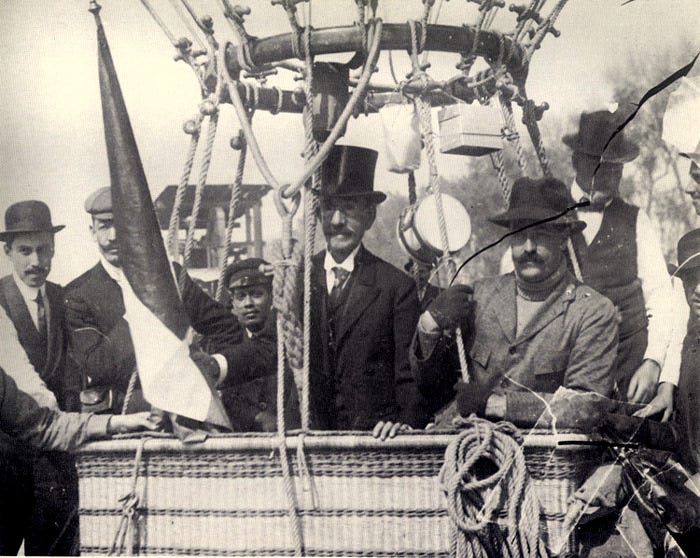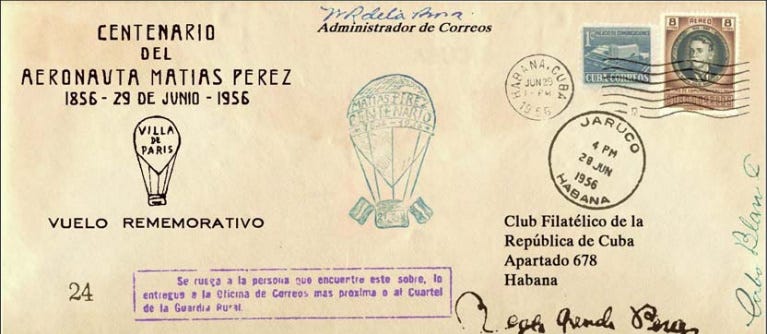The Enigmatic Disappearance of Matías Pérez and His Balloon
Written on
Chapter 1: The Legend of Matías Pérez
In Cuba, the saying “voló como Matías Pérez,” translates to “flew away like Matías Pérez.” This phrase carries a somber meaning, often used to describe someone vanishing without a trace. To grasp its significance, one must delve into the life of Matías Pérez, the aeronaut who became a legendary figure in Cuban folklore.

Many believe that the man depicted in the image above is Matías Pérez, who originally hailed from Portugal before settling in Cuba. He found success as a tailor, earning the title “rey de los toldos,” or “the king of awnings,” thanks to his lucrative business in awning construction.
Pérez was not content with merely running a business; he had grand aspirations. In an era prior to the invention of airplanes and rockets, he yearned to take to the skies. According to Alina Gomez from Cuba Plus Magazine, Matías Pérez made his first ascent in a hot air balloon in 1856, completing three flights that year. The first two were successful, but on his third attempt, adverse weather conditions prevailed. Despite this, Pérez ascended until he eventually disappeared from sight, and neither he nor his balloon has ever been found.
Hot Air Balloon Pioneers Before Matías Pérez

Historian D.C. Corbitt noted in a 1941 issue of Hispania that Pérez was not the first to fly a hot air balloon in Cuba. A Frenchman named Eugenio Robertson was the pioneer, undertaking a highly publicized flight that prompted local authorities to ensure his safety during landing. Robertson's successful flight concluded 30 miles south of Havana, igniting interest in ballooning among Cuban youth.
In 1831, a Cuban named Don Domingo Blinó also took to the skies in a hot air balloon. While he did not have the same level of official oversight as Robertson, he took precautions, offering a reward for his rescue should he land in the ocean. After two days of uncertainty, he safely returned to land, earning hero status in the local press.
Another Frenchman, Morat, attempted to capitalize on the excitement of ballooning by advertising flights over the Crimea War in early 1856, despite the impracticality of such a journey from Cuba. Morat partnered with Eugene Godard, a well-known aeronaut, who trained Matías Pérez to become a balloonist. Godard ultimately sold his famous “Ville de Paris” balloon to Pérez for 1,200 pesos.
Matías Pérez's Early Flights
Pérez soon eclipsed his mentor’s achievements. He referred to Godard with great reverence, viewing himself as a devoted student emulating his mentor's bravery. His inaugural public flight on June 12, 1856, was a resounding success, taking a group of Cuban businessmen just five miles from Havana.
Ten days later, Pérez announced a second flight, targeting a different audience through a poem that referenced "jóvenes hermosas" and "las virgenes de Cuba," or "beautiful young women" and "the virgins of Cuba." This audience shift was notable, particularly given Pérez's marital status.
The second trip was another triumph, with Corbitt humorously noting that the descendants of the women to whom he dedicated the poem have awaited his return for generations.
The Fateful Final Flight
Pérez's last flight took place on June 29, 1856. Although the weather was warm, conditions were windy with poor visibility. Undeterred, he ascended at 7 p.m., reaching an altitude of 2,000 meters before vanishing from sight. Witnesses at a lookout point reported seeing him heading north over the Atlantic Ocean, but he never returned. A search led by General José Gutiérrez de la Concha yielded no clues about his fate.
Rumors swirled around Havana regarding his disappearance; some suggested lightning struck him, others speculated he was eaten by sharks, or even captured by an indigenous tribe. There were even whispers that he took his own life due to heartbreak.

The Legacy of Matías Pérez
Matías Pérez's story has transcended time, inspiring not only a phrase about missing persons but also leading to further ballooning adventures in modern history. In 1999, Bertrand Piccard and Brian Jones completed a non-stop balloon circumnavigation of the globe, winning a million-dollar prize. In 2002, Steve Fossett became the first person to achieve a solo circumnavigation by balloon, though he mysteriously disappeared during another flight in 2007.
Pérez's legacy remains deeply embedded in Cuban culture. His story has been commemorated in plays, postcards, and even comics depicting fantastical scenarios like flying into space and being abducted by aliens. Despite his tragic fate, Matías Pérez embodies the spirit of adventure and exploration, capturing the imagination of generations long after his disappearance.
The first video titled "The Mysterious Case of The Hot Air Balloon That Vanished Into Thin Air" dives into the captivating tale of Matías Pérez and the folklore surrounding his disappearance.
The second video, "Hot air balloon incident; missing teen | Nightly Roundup," discusses a more recent incident involving a hot air balloon and the implications of disappearing into the unknown.